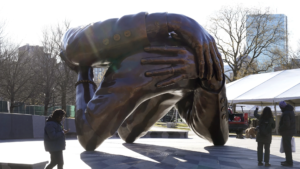Housing policy decisions in Dallas will drive racial equity over the next decade. At least, that’s the goal of a new policy approved by the city council on Wednesday.
Keren Carrión
/
KERADallas City Council members want to increase the availability of affordable housing, addressing legacies of racial and economic segregation.
For the past year, consultants and city staffers have been working to write a replacement of the city’s Comprehensive Housing Plan, which was approved in 2018.
The new policy, called Dallas Housing Policy 2033, is sweeping, and designed to address a shortage of affordable housing while ameliorating the varied problems stemming from long-standing racial and economic segregation.
Council member Casey Thomas, who heads the city council’s housing committee, said the long process that lead to the policy is worth it, because it gives the city a chance to “start again, and not just mill around the edges” on using city housing policy to address the sins of the past.
“This is giving hope,” said Council Member Omar Narvaez, who represents West Dallas. He said the plan will help reduce lingering stigma that still hurts neighborhoods in western and southern parts of the city that have faced divestment, redlining and discrimination.
A sweeping agenda
The plan starts by identifying target areas where the city can intervene to reduce barriers in housing affordability and infrastructure deficits, preserve cultural integrity and prevent displacement in gentrifying neighborhoods, and decrease racial and economic segregation.
David Noguera, who heads the city’s Office of Housing and Neighborhood Services, said it is a more proactive posture than the city has historically taken.
“Rather than just waiting for developers and residents to come to us and sprinkling around investments citywide, we’re working with the community to identify what those target areas will be, and then investing in those areas in a comprehensive manner,” Noguera said.
The plan calls for increasing the production of homes across the city, both for sale and for rent, that are affordable to low- and middle-income people. Under the plan, the city will also focus on preserving already-existing affordable housing so it isn’t torn down or abandoned, diminishing the available options.
But it stops short of setting specific production goals or proposing a budget. Noguera said that’s a decision for the city council to make.
“Until council makes decisions about how they’d like to fund this and the scale at which they’d like to fund this, it’s not appropriate for [city staff] to throw out those numbers,” said Noguera.
Revitalizing neighborhoods is a key component of the plan, using investments in infrastructure and economic development programs to improve the desirability in neighborhoods long neglected by the city. This pattern of historic disinvestment created infrastructure disparities in communities of color that undermine economic vitality.
“Functional infrastructure is a key element for developing and preserving affordable housing,” the plan states.
At the same time, the plan puts a priority on preventing lower- and middle-income residents from being pushed out as areas are revitalized, so they can enjoy the new amenities and preserve the cultural integrity and historic community ties.
It also sets a goal of reducing the concentration of affordable housing, and spreading opportunity around more broadly
A challenging debate
Community opposition often scuttles affordable housing development, and the plan includes a focus on engagement to increase support for more equitable housing landscape and greater affordability, cultivating what the plan calls a ‘Yes In My Back Yard’ mentality, and building trust from communities that have historically been left out from city priority-setting.
The measure passed 12 to 2, with Lake Highlands council member Adam McGough and Far North Dallas council member Cara Mendelsohn opposing the plan. Mayor Eric Johnson was absent.
Mendelsohn raised several objections, and said it over-emphasized building rental apartments over single-family homes and homeownership.
“What I hear over and over is that people want to own a home. And that American Dream is still alive. They may not be able to afford a home with the larger-sized lots that we require,” she said. “Not everybody wants to live in multi-family.”
That led to a testy exchange with City Manager T.C. Broadnax that exposed the challenges facing the effort to bring race and class into the discussion over housing, city policy and who gets to live where.
Broadnax said the city’s long-standing policies created a deeply uneven landscape where less expensive apartments were concentrated in southern Dallas but impossible to build in large swaths of northern Dallas neighborhoods due to restrictive zoning and community opposition.
Correcting inequities in housing and building enough affordable housing – goals the city council has voted to support, he said – means taking active steps to do things differently while also working to build community support.
“We can’t keep saying we need more affordability, and keep agreeing to, in some cases when some neighborhoods don’t want multifamily around them … saying that’s okay… [that] multifamily is fine until it shows up in your neighborhood,” Broadnax said. “So we’ve got to get past that as a community. I think this policy will help us do that.”
A deeply unequal city
The plan foregrounds the stark housing disparities facing Dallas residents. While about 52% of white households live in homes they own, just under 28% of Black households in Dallas own their homes. About 42% of Latino households own their homes.
The homes owned by Dallas households also vary widely based on race. The median white-owned home is valued at $295,000. The median Latino-owned home is worth $90,000 and the median Black-owned home value is $85,000.
The quality of housing options also breaks down on racial line: While 1 in 7 white Dallas households report having severe housing problems, 1 in 4 Black households and 1 in 3 Latino households live in homes with “severe housing problems.” That means the home lacks sufficient plumbing or kitchen facilities, is overcrowded or the occupants face a significant cost burden.
The city is also facing a shortage of affordable housing that has deepened since the beginning of the pandemic.
The greatest shortage is housing affordable to the lowest-income residents. For every 100 low-income renters – individuals making less than $30,200 a year – there are just 37 available, affordable rental units, according to the National Low-Income Housing Coalition.
For very low-income renters – individuals earning less than $18,000 a year – the numbers are even worse, leaving about 85% of very low-income residents paying more than half their income in rent.
Christopher Connelly is KERA’s One Crisis Away Reporter, exploring life on the financial edge. Email Christopher at cconnelly@kera.org.You can follow Christopher on Twitter @hithisischris.
KERA News is made possible through the generosity of our members. If you find this reporting valuable, consider making a tax-deductible gift today. Thank you.




